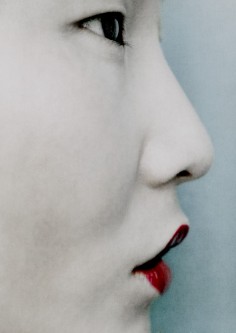ANDREAS OETTINGER AND ANKE LINZ
18seconds – Saran Tuys
source: shookdown
Anke Linz y Andreas Oettinger firmaram sus escrupulosamente maravillosos trabajos como Bill and Hells. Se conocieron en 1986 en Munich, y trazaron su unión a través de la fascinación que ambos sentían por las fotografías freaks de Diane Arbus.
Cuenta su leyenda que un día paseando por un mercadillo, encontraron un lote de líquido revelador caducado y un rollo de papel y decidieron comprarlo. Con el lote en sus manos, se les ocurrió como experimento y divertimento, revelar litográficamente algunas de sus fotografías, y con el primer revelado, nació lo que hoy conocemos como su arte.
A pesar de ser fotógrafos de moda, no utilizan modelos ni conceptos de belleza al uso -de nuevo nos encontramos con nuevas definiciones de beldad-, sino que a menudo, fotografían maniquíes humanos desprovistos (aparentemente) de la alegría de vivir, sexualidad y/o sensualidad, y rasgos perfectos. Casi cada una de sus fotografías desprende nostalgia, tristeza, introspección e incluso apatía envuelta en vivos colores y maravillosas texturas que realzan esa actitud-no-actitud que rebosan los retratados.
De hecho, en alguna entrevista, llegaron a declarar que sus fotografías eran fiel reflejo de sí mismos; ya que, inevitablemente al conocer al modelo, reflejaban en él su estado de ánimo o las sensaciones que éste les producía y viceversa, produciendo como resultado, lo que ellos consideran sus autorretratos protagonizados por los demás.
Aunque es evidente que los fotografiados proporcionan un porcentaje altísimo de esas dulces sensaciones de adormilamiento y nostalgia, quizá también se lo deban, aunque en menor proporción, a que sus texturas y colores recuerdan a las películas clásicas que eran coloreadas con la técnica del Technicolor de dos y tres colores, y por su puesto a su pequeña obsesión por los uniformes y vestimentas que pertenecieron a otro siglo; destacando por encima del resto de retratos, la multitud de enfermeras versionadas y mujeres asiáticas en diferentes papeles.
En muchas de sus fotografías podemos (e incluso debemos) plantearnos si es una ilustración hiperrealista, ya que los colores y el grano que regala el revelado litográfico consigue ese efecto de confusión que descoloca. Y mucho.
.
.
.
.
.
.
.
source: faheykleingallery
Billy & Hells’ photographs exist in a world of in-betweens. Their deceptively simple, straightforward portraits convey a certain complexity. The archetypal characters depicted in their photographs—mothers, soldiers, cowboys, nurses, and teachers— possess an underlying sense of mystery, hinting at the duality of the sitter as well as the fictional world they inhabit. Although Billy & Hells’ images call upon historical and art historical references, their portraits are not burdened by the stipulations of historical recreations. Instead, seamlessly blending past and present, reality and fantasy, their photographs become a nostalgic diary, purposefully left open for interpretation.
The duo discovered what has become their signature visual style via a typical lab-accident story— by forgetting to take a black and white negative out of the developer, they inadvertently produced an intense image with colors that appear simultaneously rich and muted. Their portraits combine elaborate, hand-painted backgrounds and draw inspiration from countless samples of fabrics, color compositions, and clothing that generate the distinct mood for each portrait.
In a special issue on Young German Photography, Deutsch magazine described the experience of viewing a Billy & Hells photograph as the following, “Inevitably, without warning, you enter a unique world of images. Each scene becomes a kind of pseudo-dwelling for the person contemplating it. The situations seem to be familiar, but you are never absolutely sure just what is happening in front of you, who the characters are, where to place the individual scenes. The commonplace is bristling with exceptions, the direction of narrative changes continually and leads you astray. Trivial things are combined with the bizarre. The mixture deriving from this casts a spell on us.” (Deutsch, “Young German Photography”, 2000 Published by Kruse Verlag, Hamburg)
Billy & Hells were nominated in 2007 for The National Portrait Gallery’s Taylor Wessing Photographic Portrait. The series “Blue Moon” was recently featured in the photographic quarterly Eyemazing. Their work has been exhibited and collected internationally. Anke Linz and Andreas Oettinger live and work in Berlin.
.
.
.
.
.
.
.
source: florencemoll
Anke Linz et Andreas Oettinger se rencontrent au milieu des années 80. Ils découvrent alors leur intérêt commun pour la photographie. S’entament alors 10 années erratiques composées d’entrainements, d’assistanats, de 15 déménagements et de 17 chambres noires. Parmi leurs icônes on retrouvent Diane Arbus, Arthur Fellong, Lucas Cranach, Ivring Penn, Richard Avedon et bien d’autres… Au début des années 90, ils conçoivent et construisent un studio lumière du jour portable conçu pour le portrait. Depuis 1995, ils travaillent pour des magazines et des agences sous le nom de Billy & Hells.


